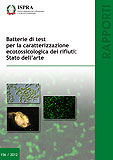Test battery for the ecotoxicological characterization of wastes: state of the art

For the classification and characterization of waste as hazardous, 15 hazardous criteria are defined in the Annex III of the Directive 2008/98/EC. The criterion H14 “ecotoxic” defines waste which presents or may present immediate or delayed risks for one or more sectors of the environment.
Ecotoxicity can be estimated using two approaches: a chemical-specific approach and an ecotoxicity-based approach. In this last case the toxicity is measured directly using different types of bioassays. For complex mixtures of unknown composition (a characteristic of many wastes) the toxicity-based approach is recognised to be the best approach to assess toxicity. Ecotoxicity tests are able to integrate the effects of different contaminants including synergic and antagonist effects and to be sensitive to the bioavailable fraction of contaminants.
It is necessary to point out that, in any case, there is no a single bioassay that can give exhaustive and suitable evaluation to all contaminants. A proper ecotoxicological characterization of complex mixtures like wastes, providing information on their potential hazard, is better obtained using a test battery of suitable and standardized bioassays.
In this paper the state of the art of the International references on the ecotoxicological batteries used for the ecotoxicological characterization of wastes, is presented.
Download the publication (pdf)
